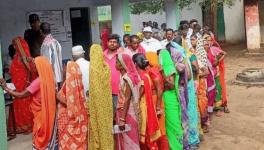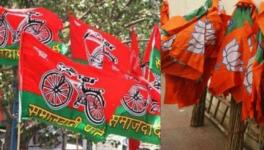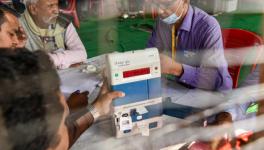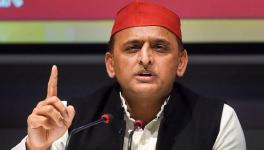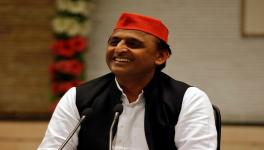Kashi Corridor: ‘Heritage has Been Sacrificed at Altar of Development’ Say Displaced Residents
Representational use only.Image Courtesy: The Hindu
Varanasi: Varanasi resident Prabhat Singh has safely kept mobile phone pictures of his over a century-old joint family house, which was acquired and demolished for the mega Kashi Vishwanath Corridor project.
These photos are his only surviving memories of his "lost home", he says.
Singh and several others in the holy city, who were displaced by the ambitious project, were not so enthused when the Kashi Vishwanath Dham was inaugurated by Prime Minister Narendra Modi on Monday.
"We were a joint family and lived together happily till our property was taken up for the corridor. Now, we live separately at different places in Benares. Not only did our century-old family property get dismantled but our joint family, too, got broken," he lamented.
On Monday, when the grand inauguration ceremony was underway at the temple complex, Singh sat lonely on a stone bench in a lane that meanders to the historic Manikarnika Ghat, where 'Moksha' is sought for the deceased.
At times, he would watch the live broadcast of the programme on his smart phone and then switch to another programme or just put his handset aside.
"It is being called 'Divya Kashi, Bhavya Kashi' celebrations. We all revere Baba Kashi Vishwanath and bow to Him, but for families like us, watching the programme is reminding us of those unpleasant memories, the demolition... all of that comes flooding back," he said.
Singh showed pictures and videos of his house when it was intact, and a picture of an old family temple endowed with beautiful carvings, dedicated to Lord Ram, in the area.
"We tried very hard to save our properties, met government officials to negotiate. But, we lost out and we removed the idols from our temple before our property got taken up earlier this year," he claimed.
The foundation stone of the ambitious project was laid on March 8, 2019, by the prime minister. Varanasi is Narendra Modi's constituency since 2014.
Singh alleged that structures of his family temple along with those of many other old temples, houses and dharamshalas, some over 250-300 years old, "were torn down to create space in the previously constricted area, filled with gullies".
"My uncle was so distressed that he would put up appeals on his Facebook feed almost every day in a tragic commentary of sorts. Was my family temple not part of heritage of Kashi," he asked.
Omkar Dikshit (37), another resident of the holy city, who runs a perfume shop started by his grandfather, said he too lost his wood-built shop to the redevelopment project.
"My 'dadaji' (grandfather) had started the shop first in Kannauj and then shifted it to a building in Saraswat Pharak area, which got consumed in the Kashi corridor project. Prior to the announcement of the project, we had already shifted our shop once in the same area, and then we got displaced. We are now running it in another lane," he said.
Lalji Yadav (72), a city resident, who lives in a lane near the project site, also alleged that several heritage buildings were bulldozed in the name of development. Many of these structures had ornate carvings and should have been preserved. "Vikas' ke liye Virasat ki aahuti di gayi hai" (Heritage has been sacrificed at the altar of development), he said.
The inauguration of the grand project had triggered a controversy, even when it was announced to decongest the temple complex and provide a direct link between it and the ghats, besides providing a number of facilities for devotees.
Under the project, the Kashi Vishwanath temple area has been expanded from 3,000 sqft to about 5,00,000 sqft and can now accommodate 50,000-75,000 people.
Varanasi Divisional Commissioner Deepak Agarwal had earlier this month said the project has decongested the temple complex which was earlier surrounded by buildings on three sides.
"To start with, the Kashi Vishwanath Special Area Development Board (KVSADB) was entrusted with the task of planning and execution of the project. The project was taken forward on a war-footing, right from getting the properties vacated to compensating the owners," he said.
"The project was executed transparently, as a result of which it faced no litigation," he said.
Forty ancient temples were found following the demolition of buildings around the main temple. These centuries-old temples were earlier hidden but are now visible. They will be preserved and opened to the public, Agarwal had said.
A Varanasi-based police personnel, on the condition of anonymity, said he has seen demolition of several "iconic buildings" at the corridor site, as, "I was posted there during the execution of the bulk of the project, soon after the ground work had begun in 2019."
"I have witnessed from close quarters the creation of the corridor that links the temple complex directly with Lalita Ghat. What has been built looks beautiful and shiny, but what we have lost in the process, the stone carvings and other heritage elements, is tragic. Development should not happen at the cost of heritage, and I will never forget those days of demolition," he said.
Modi, in his address during its foundation stone-laying ceremony, had mentioned that it was difficult to take people into confidence, persuade them to give their properties and ensure the project did not take a political colour.
"I thank the people of Kashi, who gave their properties for Baba. This is the biggest 'daan' they have given for Baba," the PM had said.
Get the latest reports & analysis with people's perspective on Protests, movements & deep analytical videos, discussions of the current affairs in your Telegram app. Subscribe to NewsClick's Telegram channel & get Real-Time updates on stories, as they get published on our website.











